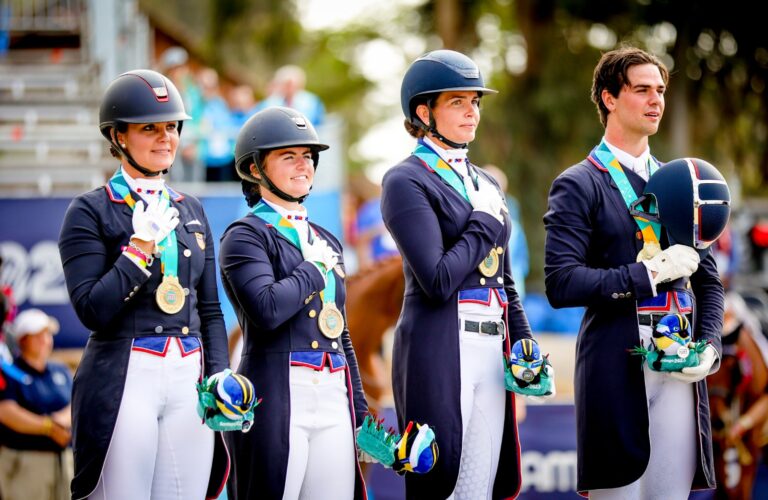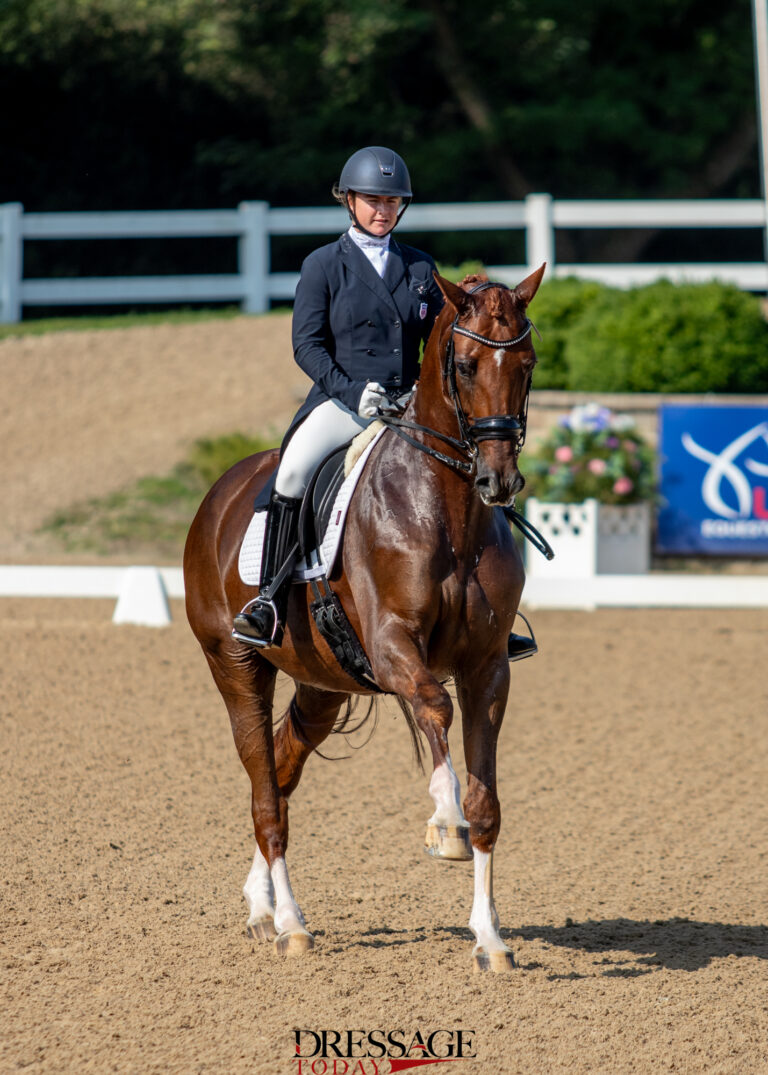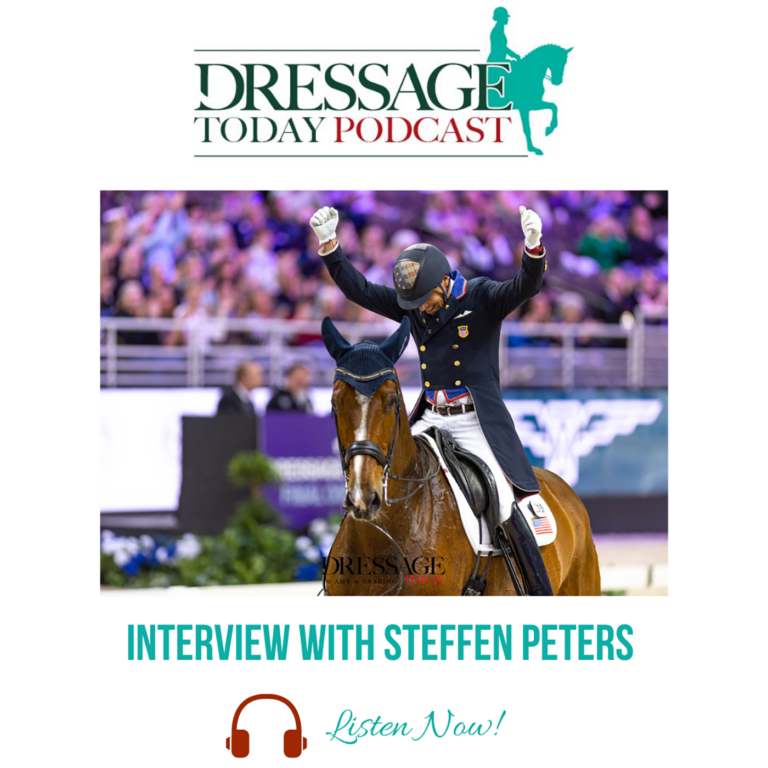
Jan, please tell us how you prepare for show-ring success and plan for consistent, high-caliber performances.
First, we honestly assess each horse and develop clear goals. Then we might go to several local/national shows, which helps us further assess each horse. Then we move on to the CDI shows.
Do you prefer getting young horses and starting them yourself or working with trained horses?
Everyone has their own preference about buying youngsters versus trained horses but I prefer getting a horse that has a flying change because it saves a lot of time. A horse with a flying change can most likely do two-tempis, so you know they will at least go to the small tour. However, starting a 3-year-old is also very rewarding because you can establish a strong relationship.
What is your daily routine?
First, I don’t believe in giving my horses a “day off” to stand in their stalls. Humans are OK to relax on the couch for a day, but for a horse that is meant to live on the prairie, keeping them closed in a stall for a day is not good. Also, a day off is not just 24 hours off. If you ride Saturday morning and then your horse is “locked up” until Monday night when you ride again, remember that is almost three days. Our stalls have runs attached so the horses, even when in stalls, can go in and out all day long. Many, but not all, are turned out on pasture. Some horses just run so much that you worry they will hurt themselves. All of them are at least hand-walked when not ridden.
We typically work the horses five days per week, Monday through Friday, with a sixth day hacking on the trail and the next on a hand walk. Monday is a warm-up day with few movements. That isn’t to say that a Grand Prix horse won’t do some movements like passage to play or a change or a pirouette, but we don’t repeat and drill the movements. We are elasticizing and gymasticizing the horse—a lot of forward and back and getting the horses soft and round. It is intense work on the basics and the low-key movements. The rest of the week depends on whether or not we are in show season.
In the off-season I typically do a lot of trail work or just ride in the jumping arena around the fences with transitions, playing with changes just to change direction as we loop around the jumps. In the off-season, I don’t let the horses fall apart. I will work more on loosening and exercising them in a frame that can build on throughness and suppleness without the stress and repetition.
During the show season, I focus more or less on test movements always with an emphasis on frame and tempo, especially as we want it to be in a test. Work with the horses is very specific with the focus on things like piaffe– passage transitions with the piaffe in place, when in the off-season the piaffe was allowed to be a bit more forward. I will ride through and sometimes repeat the movements I am preparing to perform in the test. For example, several times a week I practice halts and salutes at the beginning and end of my rides. In general, I move on if there is no problem. If there is a problem, I try to improve that particular movement. I always make sure to give my horses many walk breaks.
Show preparation plans do not end with the horses. For high-performance dressage competition, riding is more than just a job—it is really a lifestyle. I encourage the riders at my barn to take care of themselves. This includes eating right, cross-training and mental preparation. Although I used to smoke, with what we know now, I find it bewildering to see high-performance riders smoking.
What are the keys to successful performance that apply to every dressage competitor?
I tell my students to compete at the level where they know they can succeed. Then, they can build on that success. It’s a mistake to overface yourself with unrealistic expectations at a show, even if your horse is capable of doing more. While it’s important to have goals, your plan to get there begins with competing at a lower level than your goal and working your way up, building a solid foundation.
At a show, remember that horses can get tense, so plan for an extra 15 minutes to walk or maybe extra trot or canter in order to relax him. Abilities and nerves can change the time frame of your warm up, but don’t overwork your horse. Learn to read him and know what he needs.
The next step is to stick with the warm-up you do at home. After practicing your warm-up at home for a few months, you will get a pretty good idea of how much time you need at a show. Look at the training scale as a way to think about your warm-up goals. I first focus on the basic outline of the horse, the rhythm and tempo. I make sure my horse is relaxed, his back is loose and swinging and his frame is in order. When my horse and I are relaxed, I am ready to work through some of the movements in my test.
If a rider is not ready, it can be stressful for everyone. For example, if you are doing Third Level and you can’t get a flying change in the warm-up, you can become so upset that you can’t even do a shoulder-in! To regain your own and your horse’s confidence, break things down into simpler movements. Frequent walk breaks are important, too. Don’t make the mistake I often see of riders doing the same thing for 20 minutes. Leave it alone. It will only get worse and worse and not better. Come back to it when your horse is more relaxed.
It all comes down to understanding how important the basics are for both horse and rider. The rider needs a relaxed seat and good balance. The horse must be rhythmical, relaxed and be properly on the bit.
Particularly if you don’t have a trainer, you must understand the importance of the basics and work on them. This means riding your horse forward at a nice brisk tempo in posting trot and canter, riding some loops and then going on to transitions within and between the gaits. School for rideability: a few steps of a slower tempo then increase it, always improving the frame.
The movements are technically difficult, but being able to find quality in the basics is the big battle we face. If you can do that, you will be able to be successful. Don’t overuse your hands (trying to get the horse on the bit with the hands), as I often see at shows. It is technically incorrect and shows a fundamental error in your understanding of the training scale. It is easy to think of the front end because you can see that. You don’t see the hind end and it is very hard to feel. That is the one big, big, big mistake.
Practice your halts before the day of the show. They are worth as much as a more difficult movement, like piaffe, and you have to do at least two in every test. Ride square, immobile halts with the reins in one hand for a salute. Practice this a lot. It can be challenging, but sloppy halts with bad scores make it difficult to catch up, as well as creating a poor first impression with the judges.
Knowing the math of your high-value movements is important. And never perform a test in which your horse hasn’t confirmed the movements that have a coefficient of 2.
The most common error at shows is riding inaccurate figures. For example, it drives judges crazy when a rider doesn’t bend the horse correctly through the corners. Do that two or three times and your scores will drop. Another oftenseen inaccuracy is not riding your diagonal lines between the letters. A good diagonal begins with a proper corner. Then point your horse at the next letter so you can see it between his ears.
What about attitude?
Never forget that this sport is a team effort. It is not just about you and your horse. You want the right equipment and horse, but you need more than that. You need a trainer/coach that you believe in. You can question something that’s not working, but you have to trust your trainer and click with him, and that is different for everyone. Once you find that person, stick with that person even through the rough times. Long-term relationships only become deeper and more successful.
This might be the most important thing to remember: Ride at a show the same way you ride at home. Every day at home I’m focused and my goal is to have a very good ride. Then, when I go to the show, I just want to ride as well as I do at home. You set yourself up for disappointment when, at a show, you think to yourself This is going to be the best ride of my life. Instead, think of the show as just another day at the office— an extension of the good rides you have every day.
What kind of mental preparation does a rider need at a show?
Mental preparation is another key element show riders need to focus on. Many other sports encourage this more than ours does. Over the years, I’ve seen a sports psychologist and it has been very beneficial. Our team coaches have started to encourage this, too. It is more than just learning how to do your test. It is about learning to breathe and learning how to relax.
A good show rider knows her test and is prepared. Remember, anyone can make a mistake. Compete with yourself as opposed to the other riders. Having a realistic understanding of things is what can take you to new heights.
Jan Ebeling was trained in his native Germany by the late Herbert Rehbein and worked as his assistant before coming to the United States in 1984. He was the 2000 U.S. Intermediaire I Champion and, in 2003, was a member of the gold-medal-winning Pan American Games team. In 2009 and 2011, he represented the United States at the World Cup Final riding Rafalca. In 2011, he was a member of the U.S. team at CHIO Aachen. A popular clinician, he teaches riders and trains horses at all levels with his wife, Amy, at their facility in Moorpark, California (theacres.com).











